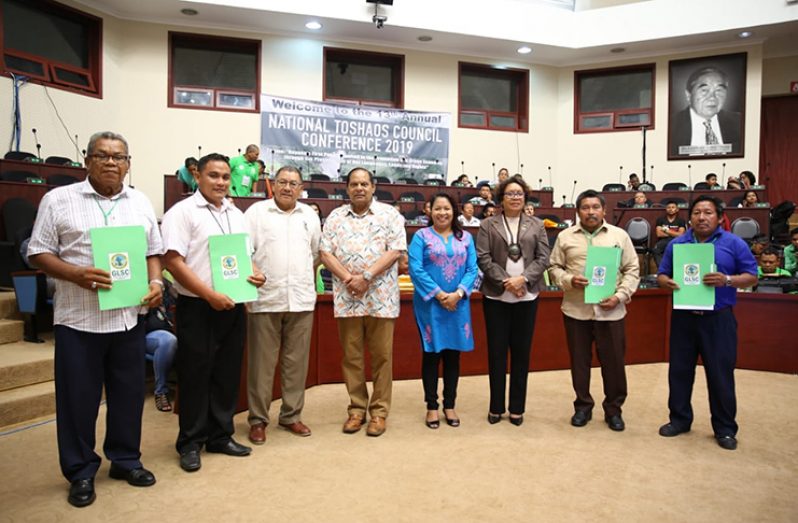GOVERNMENT, on Friday, handed over land titles to five Indigenous communities, the Department of Public Information reported.
Kangaruma and Tasserene, Region Seven; Yupukari, Region Nine and St. Monica and Mainstay/Whyaka, Region Two received their certificates of titles for their lands. The documents were handed over on the final day of the 13th annual National Toshaos Council (NTC) conference at the Arthur Chung Conference Centre (ACCC) in the presence of Prime Minister, Moses Nagamootoo; Minister of Indigenous Peoples’ Affairs, Hon. Sydney Allicock; Minister within the Ministry of Indigenous Peoples’ Affairs, Hon. Valerie Garrido-Lowe and Minister of State, Hon. Dawn-Hastings Williams.
Only last month, eight Indigenous communities in Regions Two, Seven, Nine and 10 received titles to their lands and were granted extensions. This was announced by Director-General of the Ministry of the Presidency, Joseph Harmon, who said that Cabinet has approved the absolute grants of land titles following recommendations made by the Ministry of Indigenous Peoples’ Affairs, which has responsibility for the Amerindian Land Titling (ALT) project. The grants approved are extensions to existing communities in Mainstay/Whyaka, Mashabo and Capoey, Essequibo Coast, Region Two.
The establishment of legal boundaries in Parabara, Region Nine; Rockstone, Region 10 and Tasserene and Kangaruma, Region Seven.
These communities have been waiting years for their grants of titles to move forward with the developmental of their villages. The tourism-driven communities of Mainstay/Whyaka and Capoey applied for their extension in 2011-2012 and 2014 respectively.
For decades, the residents of the mining communities of Tasserene and Kangaruma in the Lower Mazaruni fought for their land tenure status. In fact, in 2012, the former administration handed over land title certificates to the leaders of these communities, but later, officials took away the certificates.
The Amerindian Land Titling process was facilitated by the Amerindian Act of 2006 that provided for land titling and extensions. This led to the establishment of the ALT project which was scheduled to commence in 2013 and end in 2016; under the auspices of the Government of Guyana and the United Nations Development Fund, with funding of $2.2Billion (US$10.7M) provided from the Guyana REDD+ Investment Fund. The project was extended from 2016 to 2018 and subsequently from 2019 to 2021.
The Director-General explained that of the 68 interventions identified, 21 demarcations have been completed and 18 certificates of titles issued, while 45 investigations were completed – 32 for extensions and 13 for new villages. Harmon said that in approving the granting of titles, the government reiterates its commitment to the completion of the land titling project and assures that the process will continue until all Indigenous communities receive their titles in accordance with the law.
The ALT project seeks to achieve three primary goals: completion of land title issues and demarcation process for all Indigenous villages that submitted requests; increased use of existing and alternative mechanisms to resolve land titling disputes and thirdly, a communication strategy including a handbook describing the process of titling, demarcation and socio-economic impact of secured land tenure.




.png)









